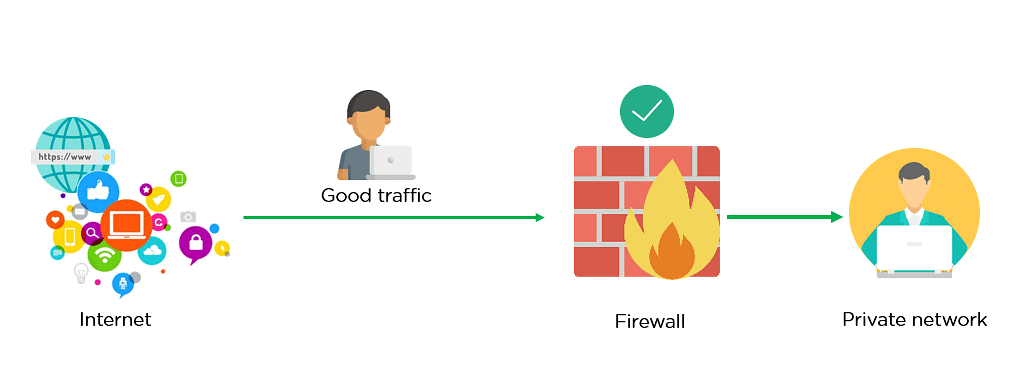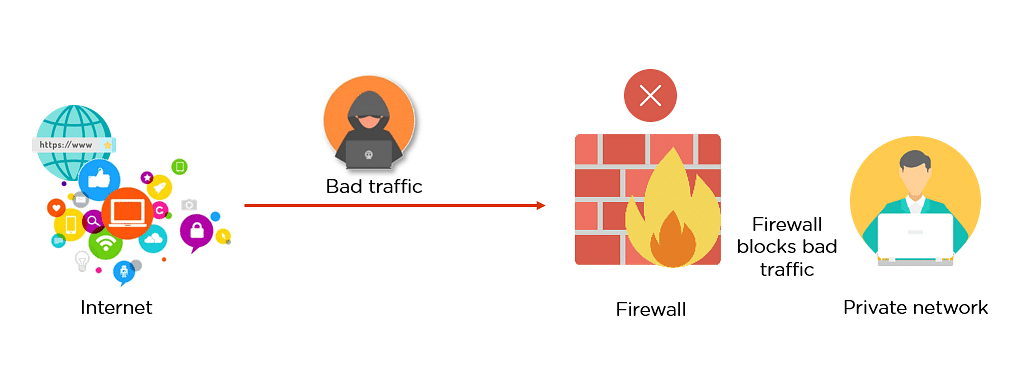What Is Firewall: Types, How Does It Work
The eight lesson of hacking : Firewall
v
With the increasing number of cybercrimes with every passing day, individuals and companies must secure their information. However, there are many challenges to implementing the same. A firewall is one such security device that can help you safeguard your network and device from an outsider. In this tutorial on ‘what is a firewall’, you will learn all you need to know about a firewall and how it acts as a shield to protect your network.
Now, let’s start by understanding what is firewall
What Is Firewall?
Fencing your property protects your house and keeps trespassers at bay; similarly, firewalls are used to secure a computer network. Firewalls are network security systems that prevent unauthorized access to a network. It can be a hardware or software unit that filters the incoming and outgoing traffic within a private network, according to a set of rules to spot and prevent cyberattacks.
Firewalls are used in enterprise and personal settings. They are a vital component of network security. Most operating systems have a basic built-in firewall. However, using a third-party firewall application provides better protection.
Now that we have understood what is firewall, moving forward we will see the history of firewalls.
History of Firewall
Network firewalls have evolved over the years to address several threats in the security landscape. Firewalls will remain crucial to organizations and society. So, let’s look at a brief history of firewalls.
- 1989 - Birth of packet filtering firewalls
- 1992 - First commercial firewall DEC SEAL
- 1994 - First of the stateful firewalls appear
- 2004 - IDC coins the term UTM (unified threat management)
- 2009 - Next Generation Firewall (NGFW) was introduced by Gartner
Now that you know the what is firewall and its history, let’s dive deeper into understanding how a firewall works.
How Does a Firewall Work?
As mentioned previously, firewalls filter the network traffic within a private network. It analyses which traffic should be allowed or restricted based on a set of rules. Think of the firewall like a gatekeeper at your computer’s entry point which only allows trusted sources, or IP addresses, to enter your network.
A firewall welcomes only those incoming traffic that has been configured to accept. It distinguishes between good and malicious traffic and either allows or blocks specific data packets on pre-established security rules.
These rules are based on several aspects indicated by the packet data, like their source, destination, content, and so on. They block traffic coming from suspicious sources to prevent cyberattacks.
For example, the image depicted below shows how a firewall allows good traffic to pass to the user’s private network.
Fig: Firewall allowing Good Traffic
However, in the example below, the firewall blocks malicious traffic from entering the private network, thereby protecting the user’s network from being susceptible to a cyberattack.
Fig: Firewall blocking Bad Traffic
This way, a firewall carries out quick assessments to detect malware and other suspicious activities.
There are different types of firewalls to read data packets at different network levels. Now, you will move on to the next section of this tutorial and understand the different types of firewalls.
Types of Firewalls
A firewall can either be software or hardware. Software firewalls are programs installed on each computer, and they regulate network traffic through applications and port numbers. Meanwhile, hardware firewalls are the equipment established between the gateway and your network. Additionally, you call a firewall delivered by a cloud solution as a cloud firewall.
There are multiple types of firewalls based on their traffic filtering methods, structure, and functionality. A few of the types of firewalls are:
Packet Filtering
A packet filtering firewall controls data flow to and from a network. It allows or blocks the data transfer based on the packet's source address, the destination address of the packet, the application protocols to transfer the data, and so on.
Proxy Service Firewall
This type of firewall protects the network by filtering messages at the application layer. For a specific application, a proxy firewall serves as the gateway from one network to another.
Stateful Inspection
Such a firewall permits or blocks network traffic based on state, port, and protocol. Here, it decides filtering based on administrator-defined rules and context.
Next-Generation Firewall
According to Gartner, Inc.’s definition, the next-generation firewall is a deep-packet inspection firewall that adds application-level inspection, intrusion prevention, and information from outside the firewall to go beyond port/protocol inspection and blocking.
Unified Threat Management (UTM) Firewall
A UTM device generally integrates the capabilities of a stateful inspection firewall, intrusion prevention, and antivirus in a loosely linked manner. It may include additional services and, in many cases, cloud management. UTMs are designed to be simple and easy to use.
Threat-Focused NGFW
These firewalls provide advanced threat detection and mitigation. With network and endpoint event correlation, they may detect evasive or suspicious behavior.
Advantages of Using Firewalls
Now that you have understood the types of firewalls, let us look at the advantages of using firewalls.
- Firewalls play an important role in the companies for security management. Below are some of the important advantages of using firewalls.
- It provides enhanced security and privacy from vulnerable services. It prevents unauthorized users from accessing a private network that is connected to the internet.
- Firewalls provide faster response time and can handle more traffic loads.
- A firewall allows you to easily handle and update the security protocols from a single authorized device.
- It safeguards your network from phishing attacks.
How to Use Firewall Protection?
To keep your network and devices safe, make sure your firewall is set up and maintained correctly. Here are some tips to help you improve your firewall security:
- Constantly update your firewalls as soon as possible: Firmware patches keep your firewall updated against any newly discovered vulnerabilities.
- Use antivirus protection: In addition to firewalls, you need to use antivirus software to protect your system from viruses and other infections.
- Limit accessible ports and host: Limit inbound and outbound connections to a strict whitelist of trusted IP addresses.
- Have active network: To avoid downtime, have active network redundancies. Data backups for network hosts and other critical systems can help you avoid data loss and lost productivity in the case of a disaster.
Build your network security skill-set and beat hackers at their own game with the Check out the course preview now!
Conclusion
In this tutorial on what is a firewall, you have understood what a firewall is and how it works. You also learned the different types of firewalls and how to use a firewall. Cybersecurity is a booming field in today's times. If you are looking to learn ethical hacking to protect devices and networks from cybercriminals. In that case, Simplilearn's will help you master advanced network packet analysis and penetration testing techniques to build your network security skill-set.
Do you have any questions on this tutorial on ‘what is a firewall’? If you do, please drop them in the comments section. We will help you solve your queries at the earliest.





0 Comments:
Post a Comment
Subscribe to Post Comments [Atom]
<< Home